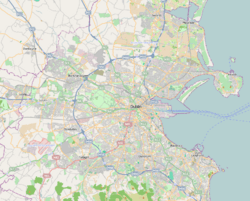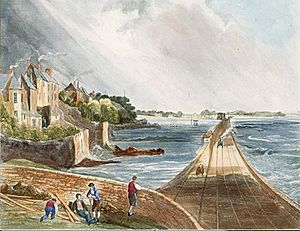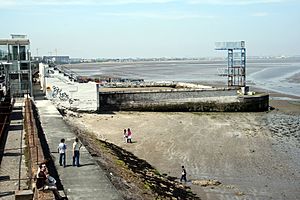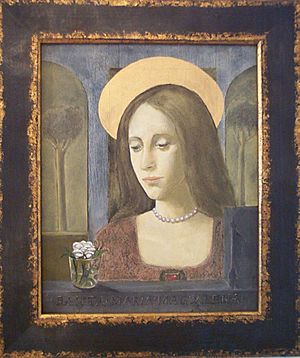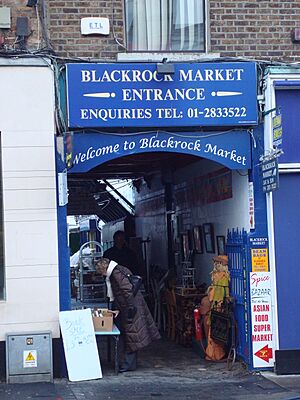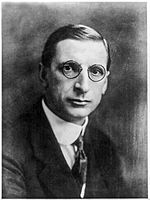Blackrock, Dublin facts for kids
Quick facts for kids
Blackrock
An Charraig Dhubh
|
|
|---|---|
|
Suburb (village core)
|
|
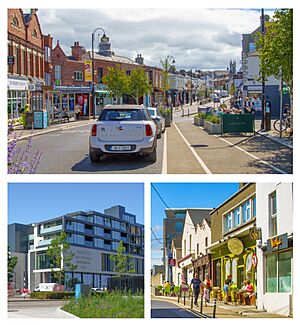
Clockwise from top: Blackrock Main Street, George's Avenue in Blackrock, the Frascati shopping centre
|
|
| Country | Ireland |
| Province | Leinster |
| County | County Dublin |
| Barony | Rathdown |
| Local government area | Dún Laoghaire–Rathdown |
| Highest elevation | 80 m (260 ft) |
| Lowest elevation | 0 m (0 ft) |
| Population
(2022)
|
|
| • Electoral division | 31,152 |
| Eircode (Routing Key) |
A94
|
| Dialing code | 01 (+3531) |
| Irish Grid Reference | O211296 |
Blackrock (Irish: An Charraig Dhubh) is a lively suburb in Dublin, Ireland. It's about 3 kilometers (2 miles) northwest of Dún Laoghaire. The area gets its name from a special black rock formation found in Blackrock Park. In the past, Blackrock was a small fishing village. It became popular in the 19th century, especially for its baths. Today, Blackrock is a popular place for visitors.
Contents
History of Blackrock
Blackrock started as a small fishing village. People have lived here since medieval times. It really began to grow in the 1800s.
How Blackrock Got Its Name
Hundreds of years ago, Blackrock had many names. Some of these were Newtown-at-the Black Rock or simply Newtown. The name "Blackrock" is a shorter version of these older names. You can still see "Newtown" in places like Newtown Avenue.
The name Blackrock comes from a unique rock formation. This rock is mostly hidden under Blackrock Park today. But it's said you can still see it north of the park's pond. The rock is a type of limestone that looks black when it's wet. This is how it got the name "Black Rock." When the railway was built in 1834, this black rock was used for walls. You can also see it in the walls of Blackrock train station.
The Old Rock Road
The Rock Road is a very old road in Ireland. It was part of an ancient path called Slíghe Chualann. This path was built by a High King of Ireland many centuries ago. It connected Tara with what is now southern Dublin. In the past, this road was sometimes dangerous. In 1787, people held a meeting to stop crimes happening on the Blackrock road. They offered a reward to anyone who could help catch criminals.
Blackrock Park's Story
Blackrock used to have a popular beach for swimming. But when the railway was built, it changed the shoreline. The area between the shore and the railway would flood at high tide. This created a smelly marsh. To fix this, the Blackrock Town Commissioners decided to fill in the area. They created Blackrock Park in the early 1870s. The park stretches from Blackrock to Booterstown. The main entrance gates used to belong to an old house called Vauxhall.
The Martello tower in Blackrock Park was built between 1804 and 1806. When it was first built, the tower was surrounded by seawater at high tide. The railway construction cut it off from the sea. But seawater still flowed in until the park was created. The part of the tower you see today is actually the first floor. The ground floor is buried underground.
In 2007, Dún Laoghaire–Rathdown County Council made plans to improve the park. These plans included fixing the Priory River and updating buildings. However, as of 2013, this work had not yet started.
Blackrock Baths: A Swimming Spot
The Blackrock baths were built by the railway company in 1839. They were right next to the Blackrock train station. You could even buy a special train ticket that included entry to the baths! In 1887, the baths were rebuilt with concrete. They had a large pool for men and a smaller one for women.
In 1928, the local council bought the baths. They got them ready for the Tailteann Games, a big sports event. The baths had a 50-meter pool. They were famous for swimming competitions and water polo games. Up to 1,000 people could watch the events.
Eddie Heron was a famous diver who lived nearby. He was the undefeated Springboard and Highboard Diving Champion of Ireland for 36 years! There's a plaque on the railway bridge near the baths to remember him.
In 1891, a brave student named Thomas Crean helped rescue someone from the water near Blackrock. He was given a medal for his courage by the Royal Humane Society.
The baths became less popular in the 1960s. This was because new indoor heated swimming pools started to appear. The Blackrock Baths closed in the late 1980s. By 1992, parts of them were taken down because they weren't being looked after. In 2013, the baths were completely taken down for safety reasons. The diving platform had become very damaged.
Historic Houses of Blackrock
Many beautiful and important houses were built in Blackrock. Some are still here, while others have been taken down.
- Frescati House: Built in 1739, this house was once the childhood home of Lord Edward FitzGerald. Even though many people wanted to save it, Frescati House was taken down in 1983. The Frascati Shopping Centre is now in its place.
- Maretimo House: This was a summer home built in 1770 for Nicholas Lawless. His son, Valentine Lawless, 2nd Baron Cloncurry, gave land next to the house for a Catholic church. Maretimo House was taken down in 1970. Apartments with the same name are there now. You can still see the private railway bridge that belonged to the house.
- Blackrock House: Built in 1774 by Sir John Lees, 1st Baronet, this house is made of red brick. It has a large coach-house and stable yard. Sir John Lees also got a tunnel built through his land when the railway was constructed. The house is still standing today, divided into apartments.
- Rosefield: This house was taken down in 1983 to build the Blackrock Clinic. It was one of the first seaside villas built in the area around 1750.
- Talbot Lodge: An 18th-century villa, it became part of the Linden Convalescent Home. It was taken down in 1989.
Religious History in Blackrock
Many different religious groups have a history in Blackrock.
- The Church of Ireland built two churches here: St. Philip and St. James Church (1822) and All Saints Church (1868).
- The Catholic Dominican Order came in the 1830s. They set up Sion Hill Convent, a girls' school called Dominican College Sion Hill, and Froebel College of Education.
- The Catholic Holy Ghost Fathers started Blackrock College in 1860. They bought several buildings over the years, which now form Blackrock College and Willow Park School.
- The Methodist community built a church on George's Avenue in the 19th century. It's now used as a community meeting place called Urban Junction.
- The Presbyterian community built St. Andrew's Church in 1899.
- The Catholic Religious Sisters of Charity opened Linden Convalescent Home in 1864. They also expanded Our Lady's Hospice to Blackrock in 2003.
- The Roman Catholic parish of Blackrock was created in 1922. The main church, St. John the Baptist, Blackrock, was built in 1845. Another church, the Church of the Guardian Angels, was built in 1967.
- The Society of Friends (Quakers) have their Dublin burial grounds at Temple Hill.
Blackrock's Features
Blackrock Town Hall and Library
The Blackrock Town Hall, Library and Technical Institute is a group of buildings on Main Street. The Town Hall was finished in 1865. The Carnegie Library and the Technical Institute were built in 1905.
Blackrock Park Today
Blackrock Park is a large green space. It was created in the 1870s by filling in a marshy area. The park stretches from Blackrock to Booterstown. The Williamstown Martello Tower is located within the park. This tower was built between 1804 and 1806. It was originally surrounded by sea at high tide.
In 2007, there were plans to improve the park. These plans included updating the Priory Stream and renovating buildings. However, as of 2013, these improvements had not yet begun.
Blackrock Baths: A Look Back
The Blackrock baths were once a very popular swimming spot. They were built in 1839 next to the train station. They had a 50-meter pool and could hold many spectators. Famous swimmers and water polo players competed here.
However, as indoor pools became common, the baths were used less. They closed in the late 1980s. By 1992, parts of the baths were taken down. In 2013, the entire structure was demolished because it was unsafe.
Location and Getting Around
Blackrock is a large area that goes from sea level up to 90 meters (295 feet) high. It is surrounded by other areas like Booterstown, Mount Merrion, and Monkstown.
How to Get to Blackrock
Blackrock has its own station on the Dublin Area Rapid Transit (DART) line. The DART train can get you to the city centre in about 15 minutes. This DART line uses the same tracks built in 1834 for the Dublin and Kingstown Railway. Blackrock railway station is the oldest train station in Ireland.
In the past, Blackrock also had tram lines, but these stopped running in 1949. Today, the closest tram service is the Luas green line in Sandyford and Stillorgan.
Many Dublin Bus and Go-Ahead Ireland bus routes also serve Blackrock. These include routes 4, 7/A/D, 17/C/D, 46E, 84/A, 114, and 7N. The Aircoach service to Dublin Airport also stops in Blackrock.
The Blackrock bypass was built in the late 1980s and opened in 1988. It's part of the N31 road, which connects the harbour at Dún Laoghaire to the main road network.
Shopping and Businesses
Blackrock is a busy commercial area. You can find many cafes, restaurants, shops, hairdressers, pharmacies, and supermarkets here. There are also art galleries and antique shops.
The Blackrock Shopping Centre was built in 1984. Across the road, you'll find another shopping centre called Frascati.
The Blackrock Market started in 1986. It has over 30 independent stalls selling all sorts of things. You can also find food stalls with different cuisines, cakes, and ethnic foods. The market is open on Saturdays, Sundays, and Bank Holidays. Many stalls and restaurants are also open during the week.
The Blackrock Clinic is a private hospital located in Williamstown.
Local Businesses and Community
Blackrock has many businesses, especially in IT and services. In 2010, a new group called the Blackrock Business Network (BBN) was formed. This group helps promote over 400 businesses in the area. They also organize fun events for the community, like the Leprechaun Chase on Saint Patrick's Day.
Population of Blackrock
In 2022, the population of the Blackrock area was 31,152 people. This number includes some areas that are usually considered outside of Blackrock itself.
Education in Blackrock
Blackrock has many schools for different age groups.
Primary Schools
- Benincasa, Mount Merrion Avenue (Catholic)
- Carysfort National School, Convent Road (Catholic)
- Guardian Angels, Newtownpark Avenue (Catholic)
- International School of Dublin, Temple Road (non-religious)
- Willow Park, Rock Road (Catholic)
- St. Augustine's, Obelisk Park (Catholic)
- All Saints, Carysfort Avenue (Church of Ireland)
- Booterstown National School, Cross Avenue (Church of Ireland)
- Our Lady of Mercy National School, Rosemount Avenue (Catholic)
Secondary Schools
- Blackrock College, Rock Road (Catholic)
- Blackrock Educate Together Secondary School, Newtownpark Avenue
- Dominican College Sion Hill, Cross Avenue (Catholic)
- Newpark Comprehensive School, Newtownpark Avenue (Church of Ireland) (includes Newpark Music School)
- Rosemont Secondary School, Temple Road (Catholic)
- St. Andrew's College, Booterstown Avenue (Inter-Denominational)
Colleges and Further Education
- Michael Smurfit Graduate School of Business is a business school of UCD.
- Froebel College of Education, Cross Avenue was a teacher training college.
- Progressive College offers childcare and healthcare courses.
- Blackrock Further Education Institute (BFEI) is located in the centre of Blackrock.
Places of Worship
- All Saints, Carysfort Avenue (Church of Ireland)
- Blackrock Methodist Church/Ignite, Main St
- Church of the Guardian Angels, Newtownpark Avenue (Catholic)
- St. Andrew's, Mount Merrion Avenue (Presbyterian)
- St. John the Baptist, Blackrock (Catholic)
- St. Philip and St. James, Cross Avenue, (Church of Ireland)
- Blackrock Community Church (Baptist)
Famous People from Blackrock
Many interesting people have lived in or been connected to Blackrock:
- Lord Edward FitzGerald (1763–1798) was born and lived in Frescati House. He was an Irish leader.
- Valentine Lawless, 2nd Baron Cloncurry (1773–1853) had a summer home in Blackrock. He was an Irish politician.
- Patrick Byrne (1783–1864) was an architect who designed many Catholic churches, including St. John the Baptist in Blackrock.
- James Stephens (1825–1901) was a founder of the Irish Republican Brotherhood.
- Charles Kickham (1828–1882) was a writer and a member of the Irish Republican Brotherhood.
- Lieutenant General Harry Hammon Lyster (1830–1922) was born in Blackrock and received the Victoria Cross for bravery.
- William Edward Hartpole Lecky (1838–1903) was a historian born in Newtown Park.
- John Boyd Dunlop (1840–1921) lived in Blackrock and invented the inflatable tyre.
- Sir William Orpen (1878–1931) was a famous portrait painter and war artist.
- Maurice Walsh (1879–1964) was a novelist known for his story The Quiet Man.
- Éamon de Valera (1882–1975) lived in Blackrock and was educated at Blackrock College. He later became a President of Ireland.
- The writer James Joyce (1882–1941) lived on Carysfort Avenue for a year. He mentioned St. John the Baptist church in one of his books.
- Kevin O'Higgins (1892–1927) was a Minister for Justice in Ireland. His life was cut short in 1927.
- Brian O'Nolan (1911–1966), also known as Flann O'Brien, was an Irish novelist and satirist.
- Cecil King (1921–1986) was an abstract painter who lived in Blackrock.
- George Thomas Stokes (1843–1898) was a historian and clergyman.
- Reginald Gray (born 1930) was a portrait painter born in Blackrock.
- Rowan Gillespie is a famous sculptor who created the "Blackrock Dolmen" sculpture. He works from Blackrock.
- Eoin Dillon, a musician from the band Kíla, grew up in Blackrock.
- Artist Fergus Martin spent part of his childhood in Blackrock.
- Actor Frank Kelly, known for playing Father Jack in Father Ted, was born and lived in Blackrock.
- Travel writer and hospital founder Sarah Maud Heckford (1839-1903) was born in Blackrock.
- Cricketer William Payne-Gallwey was born in Blackrock.
Images for kids


